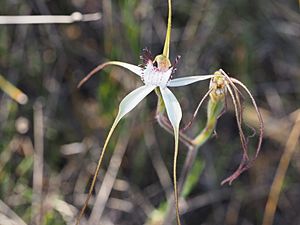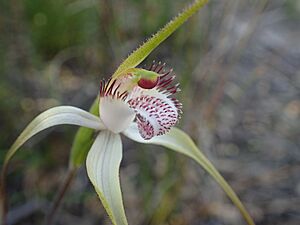Rigid white spider orchid facts for kids
Quick facts for kids Rigid white spider orchid |
|
|---|---|
 |
|
| Caladenia longicauda subsp. rigidula growing near Hopetoun | |
| Scientific classification |
|
| Kingdom: | Plantae |
| Clade: | Tracheophytes |
| Clade: | Angiosperms |
| Clade: | Monocots |
| Order: | Asparagales |
| Family: | Orchidaceae |
| Subfamily: | Orchidoideae |
| Tribe: | Diurideae |
| Genus: | Caladenia |
| Species: | |
| Subspecies: |
C. l. subsp. rigidula
|
| Trinomial name | |
| Caladenia longicauda subsp. rigidula Hopper & A.P.Br.
|
|
| Synonyms | |
|
Arachnorchis longicauda subsp.rigidula (Hopper & A.P.Br.) D.L.Jones & M.A.Clem. |
|
The rigid white spider orchid (Caladenia longicauda subsp. rigidula) is a special type of orchid that grows only in the south-west part of Western Australia. It's known for its mostly white flowers that look a bit like a spider. This orchid has a single fuzzy leaf and can grow up to three large flowers on one stem. It's similar to another orchid called the reclining white spider orchid (C. cruscula), but the rigid white spider orchid has bigger, whiter flowers.
Contents
What Does the Rigid White Spider Orchid Look Like?
The rigid white spider orchid is a ground-dwelling plant. This means it grows in the soil, not on other plants. It is also a perennial herb, which means it lives for more than two years and has soft stems, not woody ones. Every year, its leaves and stems die back, but it grows again from an underground tuber (a bit like a potato).
Each plant usually grows by itself. It has one hairy leaf that is about 10 to 25 centimeters (4 to 10 inches) long and 0.6 to 2 centimeters (0.2 to 0.8 inches) wide.
Up to three flowers grow on a stem that is about 25 to 40 centimeters (10 to 16 inches) tall. These flowers are mostly white and are quite large, about 7 to 12 centimeters (3 to 5 inches) long and 6 to 10 centimeters (2 to 4 inches) wide.
- The dorsal sepal (the top part of the flower) stands straight up. It is about 3.4 to 50 centimeters (1.3 to 20 inches) long and 0.2 to 0.3 centimeters (0.08 to 0.12 inches) wide.
- The lateral sepals (the side parts) are about 3.4 to 6 centimeters (1.3 to 2.4 inches) long and 0.4 to 0.6 centimeters (0.16 to 0.24 inches) wide.
- The petals (the inner parts of the flower) are about 2.8 to 5 centimeters (1.1 to 2 inches) long and 0.2 to 0.4 centimeters (0.08 to 0.16 inches) wide.
All these parts spread out near their base and then curve slightly downwards.
The labellum (the orchid's special lip petal) is white. It is about 1 to 2 centimeters (0.4 to 0.8 inches) long and 0.8 to 1 centimeter (0.3 to 0.4 inches) wide. It has narrow teeth up to 0.5 centimeters (0.2 inches) long along its edges. In the middle of the labellum, there are usually two or four rows of pale red bumps called calli, which are up to 0.15 centimeters (0.06 inches) long.
This orchid flowers from August to early October. It looks similar to Caladenia cruscula, but the rigid white spider orchid has larger, white flowers instead of creamy-yellow ones.
How Did It Get Its Name?
The scientific name Caladenia longicauda was first officially written down by John Lindley in 1840. This description was published in a book called A Sketch of the Vegetation of the Swan River Colony.
Later, in 2001, two scientists named Stephen Hopper and Andrew Brown described eleven different types (subspecies) of Caladenia longicauda. One of these was subspecies rigidula. Their descriptions were published in a science journal called Nuytsia.
The name rigidula comes from a Latin word meaning "stiff" or "inflexible". It refers to how the sepals and petals of this orchid spread out stiffly.
Where Does It Grow?
The rigid white spider orchid mostly grows in the area between Ravensthorpe and Israelite Bay in Western Australia. This area includes different natural regions like the Coolgardie, Esperance Plains, and Mallee biogeographic regions. It likes to grow in damp places, including shallow soil on top of granite rocks.
Is It Endangered?
The Western Australian Government's Department of Parks and Wildlife has classified Caladenia longicauda subsp. rigidula as "not threatened." This means it is not currently at risk of disappearing.


